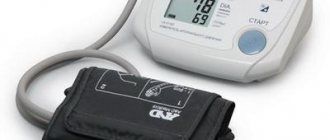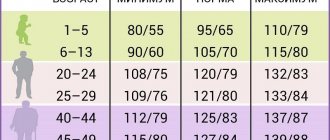Blood pressure is a measure of how much pressure is exerted on the walls of the capillaries as blood moves through them. The condition of the heart, the total volume of blood present in the body, vascular patency and other factors, including a person’s age and weight, can affect blood pressure (blood pressure). If, due to excessive physical activity or after suffering psycho-emotional shocks, blood pressure fluctuates, there is nothing to worry about, but such moments must be kept under control.
But if low diastolic pressure is constantly recorded, you need to take timely measures. Most often, the upper, systolic pressure increases when patients are diagnosed with hypertension, but low diastolic pressure is also not uncommon, and the doctor pronounces a verdict of hypotension. Next, we will discuss the causes of this condition, symptoms and ways to eliminate the problem.
What is low diastolic blood pressure?
Blood pressure readings use two numbers, written in millimeters of mercury:
- Systolic blood pressure is the top number and is the highest of the two. It shows how much pressure the blood exerts on the walls of the arteries when the heart contracts.
- Diastolic blood pressure is a smaller number that measures the pressure that blood applies to the walls of the arteries when the heart is resting between beats.
The blood pressure reading will show systolic blood pressure first and then diastolic. The doctor will analyze the person's blood pressure, assessing both indicators. For most adults, blood pressure is usually 120/80 mm Hg. Low blood pressure, or hypotension
, is blood pressure that is below 90/60 mmHg.
Low diastolic blood pressure is diastolic blood pressure below 60 mmHg while systolic blood pressure remains at normal levels.
When the heart rests between contractions, the coronary arteries receive and supply oxygen-rich blood to the heart. If diastolic pressure is too low, the heart will not receive the required amount of blood and oxygen. This can cause the heart to weaken over time.
What pressure is considered normal?
Blood pressure is divided into two indicators:
- upper (systolic) - it indicates the pressure of blood moving in the direction from the heart to the aorta and speaks of vascular resistance;
- lower (diastolic) - speaks of the strength of the blood, which returns to the heart, which is in a calm state and approaches the vena cava.
The average difference between the two blood pressure readings is 30–40 mmHg, with a blood pressure of 120/80 considered normal. Fluctuations in one direction or another, which do not affect a person’s well-being, are not considered pathological, therefore a tonometer reading of 115/75 mm Hg is not a reason for panic. There are some nuances to setting a normal blood pressure threshold.
Thus, blood pressure in older people is often higher than in middle-aged patients - this is explained by physiological changes that occur in the body over the years. Blood pressure indicators change when a person’s psychological state changes, after drinking strong tea or coffee, or after active physical activity, but at the same time it returns to normal on its own, without changing the state of health. A decrease in diastolic pressure on a regular basis indicates the development of hypotension; the same diagnosis is made to the patient if both blood pressure values - lower and upper - are constantly recorded below normal.
Reasons for decreased diastolic blood pressure
Aging may increase the risk of low diastolic blood pressure. Other risk factors include taking certain medications, such as antidepressants, diuretics, or drugs to treat erectile dysfunction.
Older adults taking blood pressure-lowering medications are at higher risk of developing low diastolic blood pressure.
Some people have low blood pressure and it does not cause them any health problems. Other people have low blood pressure due to problems with their health. These problems may include:
- diabetes
- heart disease
- Parkinson's disease
- severe infection
- anemia
- allergic reactions
Some people may also experience neurotransmitter hypotension, which is when blood pressure drops after prolonged standing.
Low blood pressure may also be due to:
- pregnancy
- long bed rest
- bleeding
- dehydration
- high salt intake
- drinking alcohol
Moving from a horizontal to a vertical position can cause your blood pressure to drop. Typically this can only last a few seconds.
A drop in blood pressure can also occur in people after they eat. It mainly occurs in older people, people with high blood pressure or people with Parkinson's disease.
Controlling blood pressure is the key to the health of the whole body
Blood pressure is a common name for two indicators: systolic (upper) and diastolic (lower). If any of them goes beyond the normal range, as well as an excessively large or very small difference between the indicators, they can be symptoms of various diseases. In order not to miss the onset of pathology and take timely measures, it is necessary to regularly measure blood pressure and consult a doctor if the measurement results do not correspond to the norm.
Symptoms
A person with low diastolic blood pressure may feel dizzy and weak. They may fall more often, which can be especially dangerous for older people.
Low blood pressure usually does not cause any problems. Within certain limits, low blood pressure can be beneficial to your health. Low blood pressure becomes a problem when other symptoms are present, such as:
- dizziness
- fainting
- nausea
- unusual thirst and dehydration
- feeling weak
- blurred vision
- cold, clammy, pale skin
- rapid, shallow breathing
- depression
- palpitations
- headache
Symptoms may go away when you sit or rest. If blood pressure drops too low, the body's vital organs do not receive enough nutrients and oxygen to function properly. This may result in shock. If this occurs, a person should seek medical help immediately.
What does the difference between upper and lower pressure mean?
If a significant difference between systolic and diastolic pressure appears due to a feeling of hunger, hypothermia, excessive physical activity combined with insufficient nutrition or constant stress, this does not mean that pathology is developing in the body. When the effect of these factors disappears, the indicators may well return to normal, and there will be no cause for concern. But if the gap between the upper and lower pressure remains at rest, this may already indicate disturbances in the functioning of the heart, blood vessels, or other body systems.
A difference of less than 25% of the upper pressure may indicate several pathological conditions:
- Myocarditis;
- Left ventricular stroke;
- Tachycardia;
- Failure of internal organs;
- Aortic stenosis;
- Heart failure;
- Heart attack due to physical overexertion;
- Cardiosclerosis.
Such conditions are often accompanied by symptoms that are difficult to ignore. These are drowsiness and weakness, headache and dizziness, impaired attention and irritability. This situation can result in hypoxia, blurred vision, and sometimes cardiac arrest, so it should never be ignored. Such indicators on the tonometer screen and poor health require medical consultation and examination.
The difference between the upper and lower pressure exceeding 50 units is considered too large. The main causes of this condition are wear and tear and aging of the cardiovascular system. In such cases, tremors of the limbs and dizziness occur, the person becomes irritable or feels complete apathy, and fainting often occurs. Causes may also include pathologies of the digestive organs or gall bladder, and tuberculosis. Only a doctor can establish the true causes and prescribe effective treatment.
Any regular or prolonged deviation of systolic and diastolic pressure from the norm is a reason to pay close attention to your health. And it doesn’t matter whether we are talking about an increase or a decrease - both options can be dangerous.
Diagnostics
To determine whether a person has low diastolic blood pressure, the doctor will use a blood pressure monitor. Diastolic value is below 60 mm Hg. is low. Your doctor may do additional tests to determine the cause of your low blood pressure:
- blood or urine tests
- electrocardiogram to read the electrical signals of the heart to determine the rhythm and any abnormalities
- echocardiogram to show detailed images of the heart
- a stress test in which a person undergoes heart monitoring while exercising
What indicators can be considered low
We all know that normal blood pressure in an adult is considered to be 120/80. In this case, the second number is the diastolic pressure. It can be assumed that all data that is below 80 should be considered pathological. But, it should be understood that each person is individual, just like his body.
Some people live their whole lives with a blood pressure of 110/70 or other indicators, and at the same time they feel very good. Accordingly, a deviation should be considered that value that is below the norm that is customary for a particular person.
Important! Usually we can talk about pathologically low DD in cases where its indicators are less than 60. Here you should consult a doctor and undergo a full examination.
Prevention
Given that age can be a major cause of low diastolic blood pressure, it is not always possible for a person to prevent it. However, maintaining a healthy weight, eating a balanced diet, and exercising regularly can keep your blood pressure levels stable and also keep your heart healthy.
Lifestyle changes can help people with low diastolic blood pressure, including:
- to give up smoking
- reducing alcohol consumption
- eating small portions of food
- drinking more water
- avoidance of sitting or standing still for long periods of time
- getting up slowly after sitting or lying down
Treatment
Treatment is prescribed only after identifying the underlying cause of the disease. If low lower blood pressure is just one of the symptoms of the underlying disease, then therapy is prescribed for the underlying pathology and the pressure is corrected during therapy.
There are also general provisions for a hypotensive patient. Firstly, this is a lifestyle correction. This concept includes several aspects:
- Normalization of sleep and rest patterns. People with low blood pressure need more sleep to feel full and productive. It is even recommended to set aside time for naps during the day.
- Nutrition correction. A balanced diet and adequate water load will provide a full range of all substances necessary for good heart function, normal circulating blood volume and good vascular condition.
- Physical activity. The main cause of lower hypotension depends primarily on the tone of the vascular wall. Dynamic exercises will help normalize tone: walking, jogging, active team games, cycling, swimming. Do not forget that you should not overload the body. Loads must be increased gradually, preferably under the supervision of a trainer familiar with the basics of physical therapy. It is necessary to take into account the presence of contraindications.
- Hardening. A method of traditional folk medicine, which is also aimed at normalizing vascular tone. It should be introduced gradually. It's best to start with a contrast shower. In this case, the water temperature should initially differ by 2-3˚C, and then gradually increase the difference in degrees. Of course, contraindications must also be taken into account.
- Be in the fresh air more often, take more walks, go to the forest, park area, away from polluted city air. Hypotonic patients are recommended to sleep with an open window to correct their chronic hypoxia.
- Normalization of the emotional background. Avoid stressful and conflict situations.
Secondly, there is also an auxiliary drug correction based on herbal preparations: Eleutherococcus, Ginseng, Schisandra. Such generally accepted methods of correcting hypotension as drinks with high caffeine content, alcohol and chocolate are not recommended by official medicine.
Forecast
Low blood pressure will not cause additional health problems. However, it can increase the risk of falls, which is especially dangerous for older people. People with low diastolic blood pressure may also have an increased risk of developing heart failure. Symptoms of heart failure include:
- shortness of breath
- persistent cough
- swelling in the lower body
- weakness
- nausea
- confusion
Researchers found a significant increase in the risk of heart damage in people over 60 years of age who had low diastolic blood pressure.
Changes in diet and exercise can help improve low diastolic blood pressure.
Related Research Article: Research suggests low blood pressure may be a cause of dementia.
Symptoms of low blood pressure
{banner_banstat3}
A decrease in blood pressure is not always asymptomatic. Sometimes it is accompanied by unpleasant or painful symptoms that require consultation with a specialist. These include:
- prolonged throbbing headaches;
- dizziness, coordination problems;
- deterioration in sleep quality;
- exhaustion;
- irritability, apathy;
- menstrual dysfunction;
- decreased sex drive;
- blurred vision;
- fainting;
- extraneous noises in the head or ears.
With a sharp drop in indicators to critical levels, a symptom complex very similar to the consequences of a stroke may occur:
- unilateral paresis (face, limbs);
- sensation of goosebumps;
- speech disorders;
- passing blindness (partial or complete).
This condition is considered an emergency. It requires immediate hospitalization of the patient and intensive care.











